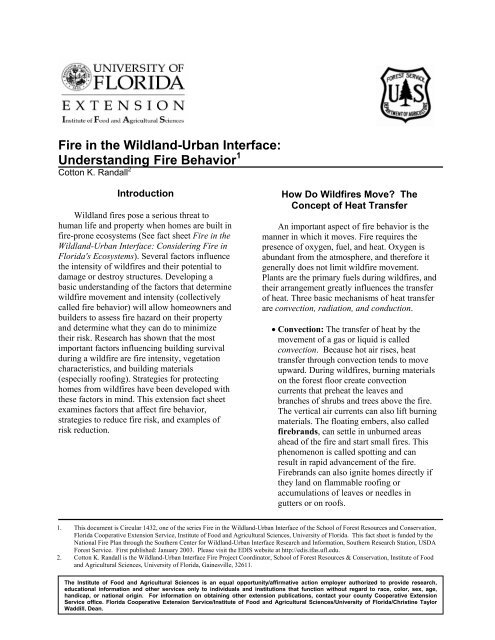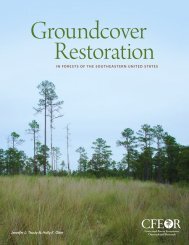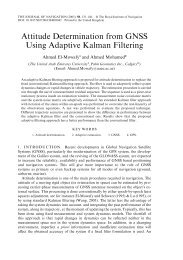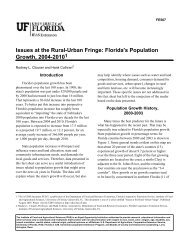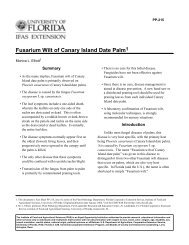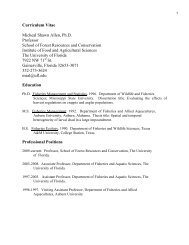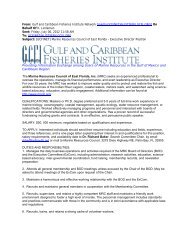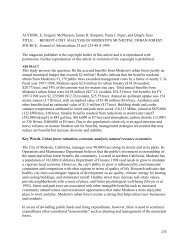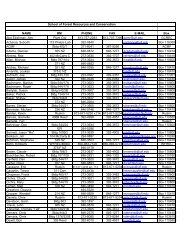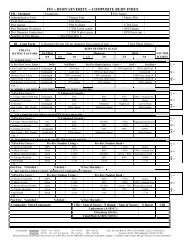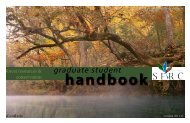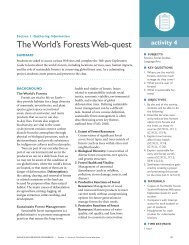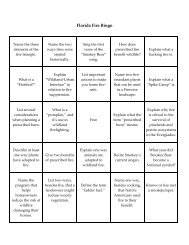Fire in the Wildland-Urban Interface: Understanding Fire Behavior
Fire in the Wildland-Urban Interface: Understanding Fire Behavior
Fire in the Wildland-Urban Interface: Understanding Fire Behavior
You also want an ePaper? Increase the reach of your titles
YUMPU automatically turns print PDFs into web optimized ePapers that Google loves.
<strong>Fire</strong> <strong>in</strong> <strong>the</strong> <strong>Wildland</strong>-<strong>Urban</strong> <strong>Interface</strong>: Understand<strong>in</strong>g <strong>Fire</strong> <strong>Behavior</strong> 4called a fire danger <strong>in</strong>dex. Many sou<strong>the</strong>rn states postcurrent fire danger <strong>in</strong>dices on <strong>the</strong>ir Web sites dur<strong>in</strong>g<strong>the</strong> wildfire season (see Appendix for l<strong>in</strong>ks). TheKeetch-Byram drought <strong>in</strong>dex is a commonly useddrought <strong>in</strong>dex associated with wildland fire dangerthat provides an estimate of dryness <strong>in</strong> <strong>the</strong> soil.Topography: Topography significantly affectsfire behavior. <strong>Fire</strong>s move faster uphill than downhill.Slope orientation also <strong>in</strong>fluences fire behavior.Forests on sou<strong>the</strong>rn or southwestern slopes generallyhave lower humidity and higher temperatures thanthose on north or nor<strong>the</strong>ast slopes because of <strong>the</strong> pathof <strong>the</strong> sun. Consequently, fire hazard is often higheron south and southwest fac<strong>in</strong>g hills.Of <strong>the</strong> three factors affect<strong>in</strong>g fire behavior, fuelsare <strong>the</strong> easiest to manage by homeowners and landmanagers to lower fire hazard.Strategies to Reduce <strong>the</strong> Risk of HighIntensity <strong>Fire</strong>sHomeowners: Homeowners <strong>in</strong> high fire hazardareas (see fact sheet <strong>Fire</strong> <strong>in</strong> <strong>the</strong> WIldland-<strong>Urban</strong><strong>Interface</strong>: Consider<strong>in</strong>g <strong>Fire</strong> <strong>in</strong> Florida's Ecosystems)can reduce <strong>the</strong> risk of high <strong>in</strong>tensity fires affect<strong>in</strong>g<strong>the</strong>ir property. An important concept for homeownersliv<strong>in</strong>g <strong>in</strong> hazardous areas is that of defensible space.Defensible space is def<strong>in</strong>ed as an area of modifiedvegetation between wildland fuels and homes thatallows firefighters to protect <strong>the</strong> home or, <strong>in</strong> absenceof firefighters, allows <strong>the</strong> home to better survive onits own. The most extensive modification ofvegetation should occur with<strong>in</strong> an area extend<strong>in</strong>g atleast 30 feet outward from <strong>the</strong> house. Beyond thisarea, additional modification of wildland vegetationcreates a larger buffer from an approach<strong>in</strong>g wildfireand fur<strong>the</strong>r decreases <strong>the</strong> risk of damage.1. Create and ma<strong>in</strong>ta<strong>in</strong> a defensible space byremov<strong>in</strong>g <strong>the</strong> lower branches up to 10 feet from<strong>the</strong> ground on large trees, separat<strong>in</strong>g beds oflandscape plants, and remov<strong>in</strong>g flammablevegetation from with<strong>in</strong> 30 feet from your house.Homeowners liv<strong>in</strong>g on a steep slope (or hillside)should ma<strong>in</strong>ta<strong>in</strong> a larger primary zone ofdefensible space by clear<strong>in</strong>g flammablevegetation from an area extend<strong>in</strong>g up to 100 feetoutward from <strong>the</strong> house. Consult your localforester or extension agent to determ<strong>in</strong>e <strong>the</strong>appropriate area of defensible space for yourneighborhood.2. Landscape your yard with fire-safe plants with<strong>the</strong> follow<strong>in</strong>g characteristics: slow growth withlittle accumulation of dead vegetation, highmoisture content and low concentrations of oilsor o<strong>the</strong>r flammable chemicals <strong>in</strong> <strong>the</strong> leaves andbranches, and open and loose branch<strong>in</strong>g pattern.3. Ma<strong>in</strong>ta<strong>in</strong> healthy landscape plants by water<strong>in</strong>gperiodically (as needed) and remov<strong>in</strong>g deadbranches (prun<strong>in</strong>g).4. If natural areas exist on your lot, reduce <strong>the</strong><strong>in</strong>tensity of an approach<strong>in</strong>g fire by remov<strong>in</strong>ghighly flammable shrubs/trees (contact yourlocal forestry agency for <strong>in</strong>formation on plantswith high fire hazard), reduc<strong>in</strong>g overall treedensity by remov<strong>in</strong>g small trees (calledth<strong>in</strong>n<strong>in</strong>g), and reduc<strong>in</strong>g <strong>the</strong> cont<strong>in</strong>uity of ladderfuels. This area can serve as a buffer betweenunaltered natural areas and a modified area ofdefensible space.Land Managers: Individuals who managelarger tracts of woodlands surround<strong>in</strong>g developedareas can also reduce <strong>the</strong> risk of high <strong>in</strong>tensity fires.This is particularly important if <strong>the</strong> lands have a highfire hazard, such as many sou<strong>the</strong>rn p<strong>in</strong>e forests. Fuelreduction on <strong>the</strong>se lands should focus on, but not berestricted to, creat<strong>in</strong>g 30-foot wide buffers at <strong>the</strong>edges of <strong>the</strong> property next to residential orcommercial developments. When prescribed fire isused to manage <strong>the</strong>se buffers, a zone extend<strong>in</strong>g from50 to 100 feet <strong>in</strong>to <strong>the</strong> forest or natural area is usuallyburned.Fuel reduction at <strong>the</strong> <strong>in</strong>terface between naturallands and developments can reduce <strong>the</strong> <strong>in</strong>tensity of<strong>the</strong> fires before <strong>the</strong>y enter populated areas. Landmanagers have several options to reduce fuels:prescribed fire, mechanical reduction (us<strong>in</strong>g mowersor heavy equipment), herbicides, and graz<strong>in</strong>ganimals. Land managers need to check localord<strong>in</strong>ances for restrictions on <strong>the</strong> use of <strong>the</strong>setreatments.
<strong>Fire</strong> <strong>in</strong> <strong>the</strong> <strong>Wildland</strong>-<strong>Urban</strong> <strong>Interface</strong>: Understand<strong>in</strong>g <strong>Fire</strong> <strong>Behavior</strong> 5Apply<strong>in</strong>g <strong>Fire</strong> <strong>Behavior</strong> Knowledge toAssess <strong>Fire</strong> HazardWith a basic understand<strong>in</strong>g of fire behavior, wecan rapidly assess <strong>the</strong> relative fire hazard of differentlandscapes. Consider <strong>the</strong> follow<strong>in</strong>g two examples:Landscape A, a natural forest composed ofmature p<strong>in</strong>e trees and a dense understory of hardwoodshrubs and small trees, is left unmanaged with<strong>in</strong> 15feet of a woodland home (Figure 6). <strong>Fire</strong> has beenexcluded from <strong>the</strong> forest for more than 10 years.Landscape B also <strong>in</strong>cludes a natural p<strong>in</strong>e forestlocated adjacent to a hous<strong>in</strong>g development (Figure7). However, <strong>the</strong> owner of <strong>the</strong> p<strong>in</strong>e forest hasimplemented a fuel reduction program that <strong>in</strong>volves<strong>the</strong> removal of all ladder fuels with<strong>in</strong> a 100-footbuffer of <strong>the</strong> development and <strong>the</strong> use of prescribedfire every 3 to 5 years to reduce surface fuels, such asdead p<strong>in</strong>e needles, downed branches, grasses, andshrubs. Notice <strong>the</strong> vertical and horizontal separationof fuels <strong>in</strong> Landscape B. In addition, <strong>the</strong> homeownercreated a 30-foot area of defensible space.vents, (2) radiant heat ignit<strong>in</strong>g bl<strong>in</strong>ds through <strong>the</strong>w<strong>in</strong>dows or rais<strong>in</strong>g <strong>the</strong> temperature of <strong>the</strong> housesexterior to <strong>the</strong> po<strong>in</strong>t of ignition, or (3) flames carrieddirectly from <strong>the</strong> forest to <strong>the</strong> side of <strong>the</strong> housethrough burn<strong>in</strong>g fuels (shrubs, p<strong>in</strong>e needles, drygrasses, or dead leaves).In Landscape B, a low <strong>in</strong>tensity surface firecould develop <strong>in</strong> <strong>the</strong> surround<strong>in</strong>g forest. With <strong>the</strong>absence of ladder fuels and a lower density of p<strong>in</strong>etrees, <strong>the</strong> likelihood of a crown fire develop<strong>in</strong>g issignificantly less than <strong>in</strong> Landscape A. If a crownfire should reach this forest, it may be reduced to asurface fire due <strong>the</strong> lack of sufficient understory fuelsto susta<strong>in</strong> it. Assum<strong>in</strong>g that only a surface firedevelops <strong>in</strong> Landscape B, how do <strong>the</strong> same threepotential home ignition sources fare? (1) The risk ofignition from firebrands would be lower than withLandscape A because <strong>the</strong>re are fewer plants toproduce firebrands. (2) The 30 feet of defensiblespace reduces <strong>the</strong> amount of radiant heat to which <strong>the</strong>house is exposed and consequently, reduces <strong>the</strong>preheat<strong>in</strong>g or ignition of <strong>in</strong>terior items and exteriorfeatures of <strong>the</strong> house. (3) F<strong>in</strong>ally, <strong>the</strong> defensiblespace reduces <strong>the</strong> chance of any flames reach<strong>in</strong>g <strong>the</strong>exterior walls of <strong>the</strong> house.ConclusionFigure 6. Landscape A with an unmanaged surround<strong>in</strong>gforest and <strong>in</strong>sufficient defensible space. Credits:Figure 7. Landscape B with a managed p<strong>in</strong>e forest andappropriate area of defensible space. Credits:Predicted <strong>Fire</strong> <strong>Behavior</strong>: In Landscape A, <strong>the</strong>presence of ladder fuels could facilitate <strong>the</strong>development of a high <strong>in</strong>tensity crown fire <strong>in</strong> <strong>the</strong>surround<strong>in</strong>g forest. Even without a crown fire, <strong>the</strong>fire could exhibit a rapid rate of spread through <strong>the</strong>understory and high radiation (hot temperatures).The potential for firebrands would also be great.Possible sources of ignition for <strong>the</strong> home would be:(1) firebrands land<strong>in</strong>g on <strong>the</strong> roof or enter<strong>in</strong>g <strong>the</strong>When wildfires occur near homes, homeownersoften feel powerless to protect <strong>the</strong>ir property. Anapproach<strong>in</strong>g fire may seem unpredictable anddifficult for tra<strong>in</strong>ed firefighters to control. However,with an understand<strong>in</strong>g of <strong>the</strong> concepts of firebehavior outl<strong>in</strong>ed <strong>in</strong> this paper, you can anticipate <strong>the</strong><strong>in</strong>tensity and movement of a fire by consider<strong>in</strong>gseveral key conditions: fuel structure, local wea<strong>the</strong>r,and topography. Fur<strong>the</strong>rmore, by alter<strong>in</strong>g <strong>the</strong>conditions around your house, such as <strong>the</strong>arrangement of landscape vegetation, type ofvegetation, and distance of vegetation from <strong>the</strong>house, you can <strong>in</strong>fluence <strong>the</strong> movement and <strong>in</strong>tensityof fires, and consequently, improve <strong>the</strong> survivabilityof your home.ReferencesCalifornia Department of Forestry and <strong>Fire</strong>Protection. 2000. Structural <strong>Fire</strong> Prevention FieldGuide: For Mitigation of <strong>Wildland</strong> <strong>Fire</strong>s. California
<strong>Fire</strong> <strong>in</strong> <strong>the</strong> <strong>Wildland</strong>-<strong>Urban</strong> <strong>Interface</strong>: Understand<strong>in</strong>g <strong>Fire</strong> <strong>Behavior</strong> 6Department of Forestry and <strong>Fire</strong> Protection, Office of<strong>the</strong> State <strong>Fire</strong> Marshal, USDA Forest Service, USDIBureau of Land Management.Cohen, J. D. 2000. Prevent<strong>in</strong>g disaster: homeignitability <strong>in</strong> <strong>the</strong> wildland-urban <strong>in</strong>terface. J. For.98(3):15-21.Foote, E. I. D. and J. K. Gilless. 1996. Structuralsurvival. Pp. 112-121 <strong>in</strong> R. Slaughter (ed.),California's I-zone. State of California.Pyne, S. J., P. L. Andrews, and R. D. Laven.1996. Introduction to <strong>Wildland</strong> <strong>Fire</strong>. Second Edition.John Wiley & Sons, Inc. New York.South Carol<strong>in</strong>a:http://water.dnr.state.sc.us/climate/sco/drought_<strong>in</strong>fo.htmlTexas:http://www.tamu.edu/ticc/fire_risk_assessment.htmVirg<strong>in</strong>ia:http://state.vipnet.org/dof/fire/csi-drought-<strong>in</strong>dex.htmNational map:http://www.fs.fed.us/land/wfas/fd_class.gifViegas, D. X. 1998. Wea<strong>the</strong>r, fuel status and fireoccurrence: predict<strong>in</strong>g large fires. Pp. 31-48 <strong>in</strong> J. M.Moreno (ed.), Large Forest <strong>Fire</strong>s. BackhuysPublishers, Leiden, The Ne<strong>the</strong>rlands.O<strong>the</strong>r Fact Sheets <strong>in</strong> <strong>the</strong> Series "<strong>Fire</strong><strong>in</strong> <strong>the</strong> <strong>Wildland</strong>-<strong>Urban</strong> <strong>Interface</strong>"(http://edis.ifas.ufl.edu):Circular 1431: <strong>Fire</strong> <strong>in</strong> <strong>the</strong> <strong>Wildland</strong>-<strong>Urban</strong><strong>Interface</strong>: Consider<strong>in</strong>g <strong>Fire</strong> <strong>in</strong> Florida's Ecosystemsby Anna L. Behm and Mary L. DuryeaAppendix<strong>Fire</strong> Danger <strong>in</strong>dices/maps on <strong>the</strong> Web:Arkansas:http://www.forestry.state.ar.us/fd/bbmap_png.php3Florida:http://flame.fl-dof.com/fire_wea<strong>the</strong>r/kbdi/Georgia: http://wea<strong>the</strong>r.gfc.state.ga.us/Kentucky:http://www.environment.ky.gov/nrepc/dnr/forestry/firewea<strong>the</strong>r<strong>in</strong>fo.aspNorth Carol<strong>in</strong>a:http://www.dfr.state.nc.us/wea<strong>the</strong>r_danger_l<strong>in</strong>ks.htmOklahoma:http://agwea<strong>the</strong>r.mesonet.ou.edu/models/fire/default.html


